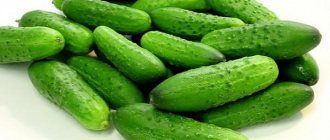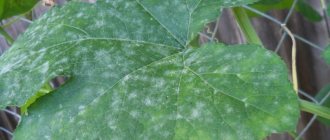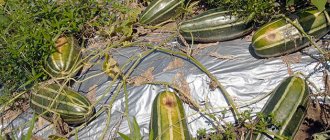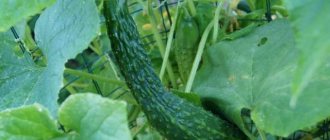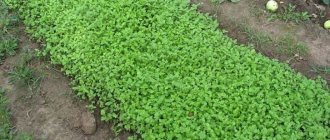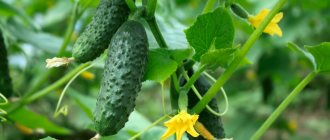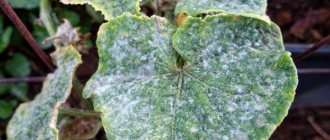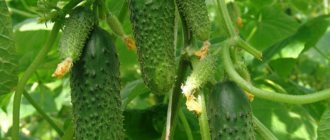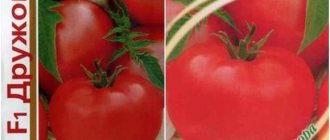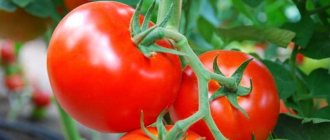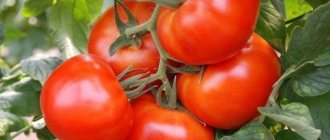For gardeners, preparations for the summer season are already beginning, despite the snow and frost outside the window. Many are already making planting plans, sorting through their seed reserves, replenishing them, deciding to try new varieties of vegetables. And in almost every farmer in our country, cucumbers occupy a place of honor in their garden beds. This is a kind of strategic reserve for the winter. Some people plant proven varieties of cucumbers year after year, which give a stable high yield.
Others like to try something new, especially since breeders regularly develop various hybrids that are immune to many diseases, do not require careful care, and still produce a good harvest. For those who like to experiment or will be planting cucumbers for the first time, we suggest using the top varieties of your favorite green vegetables.
Varieties of cucumbers resistant to diseases - description, characteristics
Without exaggeration, I can say: everyone has cucumbers in their garden. This is one of the most beloved vegetables by Russians. And they salt it, and marinate it, and put it in okroshka soups. Only to grow it and never treat it with anything against diseases is a great success. Well, who doesn’t want to grow disease-resistant cucumber varieties in their garden?!
After all, diseases can undo all our work in an instant. There will be no long-awaited cucumbers on the plants in the garden bed or trellis, in the open ground or in the greenhouse. Of course, I really don’t want to lose the harvest, and we, gardeners, throw all our strength and capabilities into the fight to save tasty and aromatic fruits. Is there a way out?
One of the preventive measures aimed at preventing the occurrence of diseases is the purchase of seeds of cucumber varieties and hybrids that are resistant to diseases. What varieties and hybrids can be recommended?
Competitor
An old, time-tested and bee-pollinated variety. One of the main advantages is high yield. Does not apply to early varieties - ripening period is 43-53 days. Black-thorned large-tuberous greens are excellent for pickling. The fruits are oval-round, 10-14 cm long, weighing up to 100 g.
Disease resistance:
- powdery mildew,
- bacterial spot virus.
Ant F1
A very popular hybrid among gardeners. Firstly, it is ultra-early - 35-39 days. Secondly, they love it for its high yield - the fruits (up to 12 cm long) grow in bunches, each bunch with from 2 to 7 ovaries. The better the illumination, the greater the harvest. It withstands accidental cold well; it will not affect the yield in any way. The plant is medium-climbing, compact, suitable for small greenhouses and greenhouses. The variety is resistant to olive spot, as well as downy and powdery mildew.
Masha F1
No less popular than Ant F1, a self-pollinating hybrid. The same ultra-early ripening, very productive gherkin-type cucumber.
Other characteristics - taste, resistance to disease, cool weather, versatility of use - coincide with the Ant F1 hybrid. Yields also decrease when natural light decreases in late summer.
Murashka F1
This is a hybrid. Early ripening - we begin to harvest 42-45 days after sowing. Fruitful. This hybrid does not need bees for pollination, as it is self-fertile. Murashka F1 is a medium-sized plant; it produces few side shoots. Zelentsy - with black spines, large-tubercular. The length of the fruit does not exceed 8-12 cm. Cucumbers of this hybrid will not be bitter under any growing conditions, at least that’s what the creators of this hybrid promise. The fruits are delicious. They are good both salted and pickled, and fresh in salads. The hybrid can be grown indoors (greenhouses, greenhouses), as well as in open ground. But the most important thing is that the Murashka F1 hybrid is resistant to powdery mildew and peronosporosis (downy mildew).
Thumb F1
A hybrid with a female type of flowering is very popular among summer residents and gardeners - the fruits are set without pollination. Early ripening. The first cucumber can be picked on the 39th day after sowing. The fruits are small, just the kind that gherkin lovers like - the length of the greens is no more than 11 cm, weight 50-65 g. The taste is excellent. Very good in salads, preparations, suitable for canning and pickling. The hybrid is resistant to a whole range of diseases - olive spot, downy mildew, powdery mildew, cucumber mosaic.
Benefit F1
Self-pollinating hybrid. From germination to fruit - 45-50 days. The average size of the fruit is weight no more than 100-120 g, length 10-12 cm. The fruit has frequent small white spines. The cucumber is tasty, strong, crunchy, sweet without bitterness, very aromatic. Universal use - salads, pickling, pickling. High resistance to root rot, cladosporiosis, cucumber mosaic virus, powdery mildew.
Alekseich F
The first cucumber of this early ripening hybrid can be tasted 37-43 days after emergence. Self-pollinating. Small neat cucumbers no more than 7-8 cm long weigh 60-80 g. The variety is universal, ideal for pickling, but suitable for fresh consumption. The taste is excellent. The hybrid resists well the most common diseases - powdery mildew, downy mildew.
Fontana F1
A long-known hybrid, it has been grown by gardeners since the 70s of the last century. Ripening period is 40-48 days. Belongs to bee pollination. The plant is tall, the length of the lashes reaches 3 m. The lashes branch well. The ovaries form in bunches. The fruits are smooth with slightly pronounced tubercles, with black spines, no more than 12 cm long, weighing up to 100 g. There is no bitterness. Retains its presentation for a long time. The hybrid is resistant to the most dangerous diseases - anthracnose and olive spot.
F1 company secret
A distinctive feature of this vigorous hybrid is its shade tolerance. The greens are cylindrical in shape with large tubercles, white-thorned, 12-14 cm long, weighing up to 120 g. The first harvest is harvested 40 days after germination.
Disease resistance:
- cucumber mosaic virus,
- cladosporiosis,
- powdery mildew.
Partial stability:
- downy mildew (peronospora).
Of course, the list of cucumber varieties resistant to various diseases does not end there. There are others! Good luck in choosing the best variety, and may your cucumber bed never know disease!
ogorod23.ru
Best Varieties and Growing Tips
Cucumber hybrids created on the basis of the Japanese varieties Cascade, Erofey, Kit, as well as Krepysh, Brunet, and Debut bred in the Moscow region are resistant to powdery mildew.
To protect vegetables from fungal infection, it is recommended:
- Observe crop rotation and return the crop to its place no earlier than after 2 years.
- Plant cucumbers in an area illuminated by the sun and inaccessible to winds.
- Plants should be repeatedly sprayed with the drug “Fitosporin” to prevent diseases, and if signs of infection appear, treat with fungicides.
- Ensure ventilation of the bushes by placing the lashes in one row.
It is necessary to sow seeds in open ground when the ground warms up to 15 °C. Humus or compost should be placed in the hole prepared for seedlings.
What is the most productive variety of cucumbers, according to summer residents?
Many summer residents cannot imagine their life without growing flowers and vegetables. One of the popular plants for planting is cucumbers. After all, they are tasty, healthy and refreshing properties that are very much appreciated in the hot summer. Many salads contain cucumbers, and they can also be preserved and eaten in winter, remembering the warm summer days. It is for this purpose that varieties have been bred that do not lose their crunchy quality even in a jar.
The value of different varieties of cucumber
Before planting, each gardener is guided by his own requirements and goals.
Some people want to get the harvest as early as possible. To achieve this goal, they plant early cucumbers. Some value certain specimens for their taste . After all, not many people like it when cucumbers have a bitter taste or a thick, prickly crust. Many hybrids do not taste bitter at all, even when overripe.
By use, three groups of cucumbers can be distinguished:
- Salting.
- Salad.
- Universal.
In addition to yield, certain varieties of cucumbers must also be assessed by the method of their use . If your goal is pickling cucumbers, then choose the most productive pickling varieties. If cucumbers are for sale, then you can choose varieties with good presentation. For fresh consumption and for salad, choose thin-skinned cucumbers without bitterness. It is recommended to plant about half of the total quantity of pickling cucumbers.
Yield champions among cucumbers
You need to choose varieties based on many factors, from ripening time to resistance to fungi and viruses.
Recently, gherkin varieties no more than 10 cm, and sometimes 9 cm, have become popular. Choosing among many options, those who like to grow cucumbers have found from their own experience those cucumbers that are good not only in the promises on the package, but also in reality. Not all varieties are early, but if we consider fruitfulness, then the most productive among hybrids and varietal cucumbers are:
- Suzanne.
- Sparta F1.
- Zozulya F1.
- Pickle F1.
- Voronezh.
- Bush.
- Pinocchio.
- Fontana.
- Crisp.
Seeds of the Suzanne variety are easy to obtain in specialized stores. Their price is much lower than other seeds. Such cucumbers can grow on the balcony, in greenhouses and in open ground. On one bush, 3–4 ovaries are formed under each leaf. Typically, the bush's lashes reach a length of 3–4 meters with optimal care. Such cucumbers are resistant to small pests , which also increases productivity. You can pick both grown cucumbers measuring 3–4 centimeters in size, as well as more ripened fruits, since they do not lose their taste.
The best hybrids by yield
The designation F 1 is often found on the packaging - hybrid seeds, obtained by crossing two different varieties to obtain the best result. These seeds are more expensive and have better properties, but their seeds cannot be collected for sowing .
These are the most popular varieties among farmers because they show high productivity, transportability and are suitable for pickling. Sparta F1. This hybrid is pollinated by bees, so it is only suitable for open ground. High yield is combined with excellent taste characteristics. Thin, delicate peel and crispy pulp; in addition, the cucumber does not become old and bitter even when overripe. Ideal for pickles and preservation.
Zozulya F1. A hybrid that can produce crops without being pollinated by bees, however, early harvests are better with pollinated ovaries. This variety provides almost simultaneous yield of fruits in the first fruitful month - up to 16 kg per square meter. m. Suitable for greenhouses with film and glazed covering. You can also grow it at home. Loves mineral supplements. The fruits are salad, with pronounced longitudinal grooves and excellent presentation . Resistant to cucumber diseases such as olive spot and mosaic.
Pickle F1. Reaches maturity in 45–50 days. It is also a fairly productive variety that is suitable for greenhouses and open ground. The cucumber is 10–15 centimeters in size. Fruiting of the variety is high and quite long. They taste excellent and do not lose their crunchy quality when salted.
The best varietal cucumbers
What's good about non-hybrid cucumbers is that you can plant several types of cucumbers and collect seeds from the one that shows the highest yield. But do not plant them next to each other, otherwise they may cross ; however, the result may be even better than from a pure variety.
Voronezh. It is a mid-late variety and matures in approximately 50–55 days. But their harvest is high. The weight of the ripe fruit is approximately 100–120 grams and has a pleasant taste. They are suitable for delicious fresh salads and for pickling. A canned cucumber will not be empty and soft.
Bush. It is an early ripening variety and ripens in 46–49 days. They save space , since the bushes and fruits are not large in size. The fruit has an approximate weight of 90–110 grams. The plant requires the participation of bees in the process of fruit formation, so they are suitable for open planting. Fresh salads are mainly prepared from them, because they taste good when fresh. They can also be used for blanks.
Pinocchio. This variety is valuable because it is resistant to cold. The fruits ripen in 44–46 days. They are pollinated by bees, which is why they need to be grown in open ground or temporarily under film. The weight of one cucumber reaches 80–120 grams. They tolerate transportation well. Suitable for preparing salads and canning. Transportability is important for growing for sale.
Fontana. Cucumber has an average ripening period of 45–50 days. Suitable for growing in open ground and under film. Cucumbers have a smooth base. They are very tasty and without bitterness . The length of one fruit is approximately 9–12 centimeters.
Crisp. Although it is a new variety, it has already shown the highest yield, which earned it a place on the list. Suitable for planting in open ground and in greenhouses, as pollination by bees is required. The length of a ripe cucumber reaches 10–15 centimeters. By its name it shows that it was created for crispy preservation.
Of course, this is not the entire list of the most productive cucumbers. After all, in fact, there are a huge number of varieties and breeders are constantly working to create both the most productive and the most resistant to diseases. It is worth noting that all cucumbers are tasty in their own way. Well, it’s up to you to choose which one to plant.
The most productive varieties of cucumbers for greenhouses
Those cucumbers that are capable of self-pollination are suitable for harvesting in greenhouses. These hybrid varieties were created by breeders specifically to produce greenhouse crops. They tend to be versatile, transportable, and disease resistant .
Let us note the most fruitful among these cucumber varieties. Alekseich F 1. An early ripening hybrid that ripens in 37–45 days from the moment of emergence. This is a universal medium-sized variety with a fruit weight of 60 to 80 grams. It has mild tubercles and excellent taste. A factor of good immunity to fungi, such as mealy and powdery roma, is important.
Benefit F 1. A variety of early ripening hybrids. About 43–50 days pass from the first shoots to the mature fruit. The variety is medium-sized, universal in its qualities and has fine tuberosity. The fruits weigh 100–120 grams and measure 10–12 cm. Resists diseases of powdery and downy mildew, as well as an unpleasant disease of wet soils and greenhouses - root rot.
Meringue F 1. The earliest variety of cucumbers suitable for amazing preservation. Ripens in 37–39 days from germination. The fruits are large-lumpy, dark green in color and weighing 80–100 grams. This hybrid is used in greenhouses and also in open areas. Resistant to mosaic viruses, powdery mildew and cladosporiosis.
Murashka F 1. Interesting early ripening variety. This hybrid blooms in bunches, forming very few lateral shoots. This is convenient, since caring for such bushes in terms of removing excess greenery is minimal. Ripens in 42–45 days from emergence. The variety is large-lumpy, has thorns and is not bitter . Medium-sized cucumbers weighing from 80 to 100 grams. An excellent universal hybrid that is resistant to powdery and downy mildew.
Getting a high yield depends not only on the variety of cucumbers, but also on the place where you grow them, as well as resistance to various diseases. Before planting cucumbers, you should study the basic data indicated on the package of seeds:
- their degree of susceptibility to disease;
- ripening time after the first shoot;
- taste qualities;
- resistance to sudden temperature changes.
So, knowing all the necessary information, you will choose not only the most beautiful picture on the cucumber seeds, but also the most suitable variety.
ogorod.guru
Middle-late crops
Early cucumbers are rarely used for winter preparations, since they are eaten fresh. For preservation, later varieties grown in open ground are best suited.
fontanel
The hybrid, created in Moldova several decades ago, was loved by summer residents for its ease of care, high yield, and excellent taste of cucumbers. Many gardeners, having tried to grow other varieties, plant Rodnichok again. On bushes with long vines, the fruits begin to ripen in July and are valued:
- for the same size;
- light color;
- crispy pulp;
- no bitter taste.
Cucumbers, which weigh only 90 g, are salted and pickled.
The plant is not afraid of cold weather, practically does not get sick, and its yield is not inferior to parthenocarpic hybrids.
Cucumber varieties for the middle zone
Hello, dear friends!
I’ll start the article with a question from my reader O. Filina:
“In the conditions of the middle zone, cucumbers are susceptible to a number of certain diseases, in which we are unable to obtain a full and high-quality harvest. Tell me, what hybrids and varieties of cucumbers are best to plant for the middle zone?”
“What diseases are most affected by cucumbers in the middle zone?”
Most often, cucumbers are affected by downy mildew (see article), powdery mildew (see article), bacteriosis (see article), and ascochyta blight.
“What contributes to the development of these diseases?”
The development of these diseases is facilitated by certain weather conditions in our area.
“What varieties of cucumbers, in this case, would you recommend planting?”
There are many varieties that can be recommended that will be resistant to diseases of this kind. For example, these are varieties such as Stork, Phoenix, Lotus, Salting, Abundant, Unity and Whale. These varieties are recommended by experimental stations in other regions, but you can safely plant them in your garden. In the middle zone and the middle Volga region they have proven themselves well.
“Tell me more about the benefits of each variety.”
For example,
- The Phoenix variety of the Crimean Experimental Station has complex high resistance to diseases that affect cucumber in our conditions, but it should be taken into account that this variety belongs to late-ripening varieties. In addition, this variety is recommended for late (June) plantings and the main harvesting of the fruits of this variety begins when most varieties no longer bear fruit.
- The Lotus variety (Far Eastern Research Institute of Agriculture) is resistant to downy mildew and is also mid-season, but the Kit variety is resistant to bacteriosis.
- The Volgograd Experimental Station offers the Zasolochny and Obilny varieties as cucumber varieties for the middle zone.
- The variety Unity of the All-Russian Scientific Research Institute for Selection and Seed Production of Vegetable Crops is distinguished not only by its resistance to diseases, but also by its stable yield.
“Can you recommend any cucumber hybrids for growing in our conditions?”
We can recommend the following hybrids: Golubchik F1, Crane F1, Claudia F1, Semcross F1, Farmer F1, Nightingale F1.
“What are these hybrids good for?”
- Hybrid Golubchik F1 is distinguished by a friendly early harvest, and is also resistant to powdery mildew, downy mildew and the cucumber mosaic virus.
- Crane F1 is a very well-known hybrid, resistant to downy and powdery mildew. This hybrid grows well in our conditions and is to the taste of many gardeners, not only in fresh, but also in pickled form.
- Hybrids Claudia F1 and Farmer F1 have complex resistance to diseases, and Claudia also has high taste.
- The last hybrid that can be recommended for growing in the middle zone and middle Volga region is the Semcross F1 hybrid. It is resistant to real as well as downy mildew and the cucumber mosaic pathogen.
Of course, I didn’t talk here about all the suitable varieties of cucumbers for the middle zone.
and the middle Volga region, since there are very, very many of them. But these ones have been tested by me in the garden beds!
See you later, dear friends!
ayatskov1.ru
Early ripening cucumbers
In small plots, gardeners grow root vegetables and beans, tomatoes and cabbage, but even in a polycarbonate greenhouse they always leave room for early cucumbers.
Diva
Climbing bushes of an early ripening hybrid, bred in Russia, bear fruit abundantly in loggias, on window sills, balconies, and not just in greenhouses. In the leaf axils, 3–8 greens are laid in bunches.
The first Primadonna cucumbers ripen in 35 days, weigh 80–85 g, new fruits are formed before autumn.
Masha
A self-pollinating variety that successfully resists powdery mildew, withstands cold weather, and is highly productive is popular among gardeners. The yield of the Masha hybrid decreases in the fall, and the gherkins, which grow in bunches, have an excellent taste.
See also
TOP 30 best types of determinate varieties of cucumbers with descriptions
Read
Thumb Boy
Many summer residents like the early-ripening variety with female flowers, which does not suffer from mosaic, peronospora, or powdery mildew. Miniature oblong gherkins weigh only 50 g, crispy in pickles, and very tasty.
The best varieties of cucumbers resistant to peronosporosis
�
The most resistant to peronosporosis varieties of the Far Eastern selection: Dalnevostochny 27 (DS -27), Mig, Cascade, Onyx, Stimul, Dalnevostochny 6, Vladivostoksky 155, Avangard 121. These varieties can be grown without the use of chemical control agents, replacing them with foliar feeding (spraying leaves ) plants with a 0.5-1% solution of urea (carbamide) along with microfertilizers: potassium, manganese, boron. Urea, or carbamide, is a nitrogen mineral fertilizer that is available for sale in hardware stores.
To prepare the solution, you need to dissolve 50-100 g (2 tablespoons) of urea in 10 liters of water, add 2 g of boric acid, 2 g of copper sulfate, 3-4 g of potassium permanganate (potassium permanganate). Two grams is a third of a teaspoon without the top. Copper sulfate can be purchased at hardware stores, boric acid and potassium permanganate at pharmacies and medical posts. The prepared solution is enough for 50 square meters. When cucumbers are grown over large areas, the norms for foliar feeding are as follows: 7-10 kg of urea, 120-150 g of copper sulfate and boric acid and 200-250 g of potassium permanganate per hectare. Water consumption -500-600 l/ha.
For the first time, plant leaves are treated with this solution after the first signs of downy mildew (yellow spots on the leaves) appear, and then twice more with an interval of 8-10 days. For the purpose of prevention, foliar feeding of plants can be started after the appearance of 3-4 true leaves. During the period of mass fruiting, it is advisable to do 1-2 more feedings, which contributes to better fruit set and the appearance of more female flowers. It should be emphasized that varieties of Far Eastern selection give a good harvest only if they are fed foliar. If this is not carried out, they are affected by the disease and die, like ordinary varieties.
Common diseases of cucumbers
Early detection of the disease increases the chances of its elimination. The most common diseases of cucumbers:
Powdery mildew
It affects the leaves and sometimes the stem with a white coating formed in small spots. Over time, this plaque will spread to the entire leaf, which begins to turn yellow and then dries out. Refers to fungal diseases that cause the plant to wither and stop fruiting.
The source of occurrence may be pathogens remaining from organic residues. It spreads best in the absence of solar heat.
When the temperature rises to 20 degrees, the development of powdery mildew slows down or stops altogether. The most susceptible to diseases are cucumbers that have been watered little or irregularly, as well as those that are oversaturated with nitrogen fertilizers.
To prevent the onset of the disease, you must:
- Be sure to adhere to crop rotation.
- thoroughly clean all plant debris from the greenhouse
- carry out disinfection after fruiting.
- raise the temperature above 23 degrees
- Watering is carried out exclusively with warm water
When primary symptoms occur, spray with fungicides. The procedure requires dry and windless weather.
Downy mildew
It can be identified by small light yellow spots; over time they increase in size and the leaves turn brown and dry out. It is caused by a fungus and multiplies due to increased soil moisture and watering with cool water.
To prevent the disease, the advice is the same as for powdery mildew. If signs of the disease are detected, Bordeaux mixture is sprayed; after the procedure, care should be taken to maintain the temperature within 25 degrees.
Brown olive spot (cladosporiosis)
Small, brown and round ulcers appear on the stem and cucumbers, and after a couple of days they darken and grow. Spots begin to form that are destroyed when dried. Occurs when there is high humidity and sudden changes in temperature. Water spreads the fungus to new plants or leaves spores in the soil.
To avoid infection, you need to ventilate the greenhouse more often, use warm water and not use the sprinkling method, do not leave all plant residues inside the greenhouse, and observe crop rotation. When the first spots appear, stop watering for several days, maintain the temperature at least 20 degrees and treat with one percent Bordeaux mixture or copper oxychloride solution.
There are many more diseases, but they all boil down to the fact that the leaf deteriorates and the development of the fruit stops. And the spread of the disease is helped by coolness and excessive moisture. Care should be taken to ensure that the disease does not spread.
The best varieties of cucumbers from Moldovan breeders
�
Good results can be achieved by growing the best varieties of cucumbers and hybrids of the Moldavian National Institute of Vegetable Growing and Irrigation Agriculture: Mirabella, Favorit, Intermission, Vernissage, Contact, Pilog, Business, Skadron. They are recommended by Moldovan breeders for cultivation in spring and summer greenhouses and in open ground and have increased resistance to peronospora, bacteriosis and anthracnose. A characteristic feature of these varieties and hybrids is that even when affected by peronosporosis, they grow well, produce a lot of ovary and, as a result, high yields.
Also worthy of attention are the varieties Aquarius and Electron, bred at the Research Institute for Selection and Seed Production of Vegetable Crops, the hybrid Topolek and MVVIR-1, the varieties Svezhest, Dean, Brigadny and Phoenix, bred at the Crimean Breeding Experimental Station of the Krasnodar Territory. We need to talk about the last variety in more detail, since a lot is now being written about it and is considered resistant to downy mildew.
Phoenix is one of the best varieties of cucumbers
�
Indeed, Phoenix is one of the most resistant varieties. Of course, it is sensitive to peronospora, but it is affected much less than other varieties, and most importantly, it has the ability to quickly increase green mass to replace the affected one, which is not characteristic of unstable, but very common traditional varieties.
Phoenix is a late-ripening variety, fruiting begins on the 50-55th day after germination and continues until autumn frosts. This is precisely its advantage over other varieties, which produce products for 1.5-2 months, while Phoenix - 3.5 - 4 months. Under no circumstances should crops of this variety be thickened, because the bulk (90%) of cucumbers grow on shoots of the first, second and third orders.
Phoenix is grown using a two-tape method, the distance between the tapes is 60 cm, in a row 15 cm. After the appearance of the first true leaf, the plants are broken through, leaving 20-25 cm between them. By the way, the density of crops significantly affects the yield of cucumbers, it is the cause of a large number of barren flowers (male flowers) and a decrease in the number of ovaries. Therefore, it is advisable not to thicken the crops of cucumbers, especially those with long tops (for example, Far Eastern varieties should have no more than 5 plants per 1 sq. m.).
Many gardeners grew hybrids of Dutch selection: Parker, Furax, Anka and Serena. By mid-July they had already produced a good harvest. However, it should be noted that Dutch varieties are very early, ripen within a month and disappear very quickly, and fresh produce is needed until late autumn and also for winter preparations, so it is better to give preference to domestic varieties and hybrids.
Prevention of occurrence and effective methods of treatment of peronosporosis of cucumbers
When growing cucumbers, gardeners often encounter a wide variety of plant diseases. One of the most dangerous is peronosporosis. If cucumbers are not treated, the foliage of the affected plant dries out, after which it dies.
Diseased cucumber bushes are a depressing sight. The gardener thinks not only about the loss of the harvest, but also about the contamination of neighboring plants and related crops. How to help cucumbers with peronosporosis and what to do to prevent the disease in the future, we will tell you in this article.
What is peronosporosis
Downy mildew of cucumbers (downy mildew) is a fungal disease caused by lower fungi, oomycetes.
Cucumbers, like other plants of the pumpkin family, are attacked by Pseudoperonospora cubensis.
Pathogenic spores persist on plant debris and in the soil. In spring they are carried by wind and raindrops.
Penetration and infection are facilitated by mechanical damage to plants.
Downy mildew is found everywhere: cucumbers can get it both in open and closed ground, that is, in greenhouses and greenhouses.
Why are cucumbers dangerous?
The harm of peronosporosis lies in damage to the leaf apparatus of the vegetable. The tops turn yellow and die, and photosynthesis processes are disrupted. Plants may die within a week.
Even if the infected bush blooms and bears fruit, their quality and quantity will be extremely low. Losses due to disease account for 30-100% of the crop.
Symptoms of the lesion
Downy mildew is diagnosed by several characteristic features. Our photos will help you identify the disease.
External signs
Yellow angular spots appear along the veins on the upper side of the leaf. Over time, the lesions acquire a brown tint. The edges of the leaves turn upward.
After 1-2 days, a grayish or whitish coating appears on the back side of the leaf blade.
Infected plants are stunted in growth, stems and root systems weaken. The affected tissues have a faded, limp appearance.
Stages of development
Downy mildew develops rapidly. The incubation period at a temperature of 18ºC and 100% relative humidity is three days.
The disease occurs in several stages, which quickly replace each other:
- At the initial stage, yellow spots appear.
- The affected areas become oily. On the reverse side of the leaf, spore-bearing organs sprout - areas of grayish or white coating, velvety in appearance.
- The spots turn brown and increase in size.
- The foci of infection merge. The leaf dries out and falls off.
- The final stage is characterized by large-scale death of the leaf apparatus and death of the plant.
Risk factors
A decrease in air temperature to 15-20 º C and rainy weather increase the risk of infection. Planting cucumbers in shaded and poorly ventilated areas contributes to the development of the disease.
Too dense plantings, insufficient insolation, and relative humidity above 80% are risk factors for greenhouse vegetables.
Treatment of cucumbers
Oomycetes are not easy to eradicate. It is unlikely that it will be possible to completely save the crop, but it is possible to help the plants.
Destruction of affected areas
When a small number of leaves are affected, they should be removed without regret and destroyed outside the site. This will help prevent the spread of infection.
However, one cannot limit oneself to such a measure.
Agrotechnical techniques
Agrotechnical control measures include:
- Regular weeding and removal of plant debris. This technique promotes better ventilation of plants.
- Timely and reasonable feeding. Gardeners note that the degree of infection increases with a lack of potassium and phosphorus, as well as with an excess of nitrogen.
- Ventilation of greenhouses and removal of overgrown shoots.
Biological agents
Fungicides of biological origin are recommended for use in the initial stages of the disease or for prevention. As an example, here are a couple of drugs:
- "Trichodermin." Contains live spores of the fungus Trichoderma sp. When they germinate, they release antibiotics and substances that have an antifungal effect. The drug is available in the form of a powder or aqueous suspension. To spray plants, prepare a working solution from 20-40 ml of liquid or 20-40 g of powder and 5 liters of water. Consumption - 5 liters per 1 hundred square meters.” Trichodermin" is used at a temperature not lower than 18 º C, otherwise beneficial spores are not activated. Safe for bees. May cause allergic reactions upon contact.
- "Planriz." Created based on living soil bacteria Pseudomonas fluorescens, which produce natural fungicides. The product is produced in the form of a liquid in bottles of various sizes. To prepare the working fluid, take 10 ml of the mother solution per 10 liters of water. Root spraying is carried out at the rate of 0.5-1 liters per 1 m². Safe for humans and insects. The shelf life of the drug is limited to three months.
Important! Biological products are incompatible with any pesticides. They should be used no earlier than two weeks after the last chemical treatment.
Chemicals
If time is lost and the infection has spread throughout the cucumber bed, only chemicals will help
The following drugs are suitable for the treatment of peronosporosis:
- Previkur Energy. The active ingredients are propamocarb hydrochloride and aluminum fosetyl. The drug has a narrowly targeted effect and destroys exclusively oomycetes, which include the causative agents of peronosporosis. 25 ml of the product are diluted in 10 liters of water and watered at the root, avoiding contact with the leaves. The consumption of the working solution is approximately 10 liters per 1 hundred square meters. A maximum of three treatments are carried out with an interval of 10-14 days.
- "Kuprolux". A preparation based on cymoxanil and copper oxychloride of contact-systemic action. Low danger to bees and humans. Available in the form of a wettable powder. For spraying, prepare a solution of 25-30 g of the substance and 10 liters of water. Treatment is carried out no more than three times per season with a break of 10-12 days.
- Copper oxychloride (“CHOM”) is an inexpensive drug with protective contact action, recommended for use as a prophylactic agent. The frequency of treatments is three times per season with an interval of about two weeks. Liquid for treating plants is prepared from 40 g of the substance per 10 liters of water. Spraying is carried out at the rate of 1 liter per 10 m². Poses moderate danger to humans.
Important! To preserve the effect of chemicals, you need to carefully treat the underside of the sheet.
Traditional methods
Traditional methods are safer, but not as effective as pesticides. Most often they are used as preventative measures or at the very beginning of the disease.
Experienced gardeners advise trying several recipes:
- Soda. Dissolve 40 g of baking soda in 5 liters of boiled water, add 15 ml of liquid soap. Spray the bushes and soil with the resulting mixture once a week.
- Onion peel. Pour 500 g of onion peel into 10 liters of water and boil. Leave to infuse in a dark place for 1-2 days. Strain the infusion and spray the cucumbers several times a month.
- Potassium permanganate. Spray the plants with a weak solution of potassium permanganate (1-1.5 g per 10 liters of water) once a week.
- Milk serum. Add 30 drops of pharmaceutical iodine and 30 g of grated laundry soap to 1 liter of whey. Spray the bushes as a preventative measure once every 10 days.
Features of treatment in a greenhouse and open ground
The principles of treatment of peronosporosis are common for indoor and open ground.
The difference is that it is easier to regulate the microclimate in a greenhouse. To reduce humidity, ventilation is carried out more often. Bricks or stones are used to maintain temperature. They warm up during the day and give off heat at night. Water containers work on the same principle.
Special care should be taken when using chemicals in a greenhouse. After treatment, it is recommended not to enter the room for a day.
Preventive measures
Prevention of downy mildew is simple. A number of measures will help protect plants:
- In the fall, be sure to remove all plant residues from the beds and burn them.
- Cucumbers are not planted in the same place year after year.
- Before planting, treat the seeds in a 0.1% solution of potassium permanganate for 30 minutes.
- They follow the rules of agricultural technology: they regularly weed the beds and apply fertilizers in accordance with the needs of the plants.
- To increase the immunity of vegetables, stimulating drugs are used: potassium humate, Gumistar, Baikal EM-1.
- Water the cucumbers only with warm, settled water.
Resistant varieties and hybrids
Planting plants that are resistant to it will help reduce the risk of downy mildew. There are no cucumber varieties and hybrids with complete resistance to this disease. However, many of them have sufficient immunity.
Thus, during an epidemic of downy mildew, within 12-18 days from the beginning of fruiting, hybrids such as:
- Artek f1;
- Doubler f1;
- Baby crane f1;
- Swallow f1;
- Octopus f1;
- Eaglet f1;
- Semcross f1;
- Swift f1;
- variety Chizhik and others.
The following varieties have the maximum possible ability to bear fruit within 21-28 days with a strong spread of the disease:
- Far Eastern 27;
- Moment;
- Phoenix;
- Phoenix plus.
Varieties with complex resistance to fungal pathogens include:
- Little Cupid;
- Erofey;
- Cascade;
- Whale;
- Lotus;
- Swag.
Hybrids have also been bred that have no doubt about their resistance to downy mildew:
- Brunette f1;
- Debut f1;
- Katyusha f1;
- Beauty f1;
- Sturdy f1;
- Frant f1.
Source: https://agronom.expert/posadka/ogorod/tykvennye/ogurets/metody-lecheniya-peronosporoza.html
What seeds are best to use for sowing?
�
Seeds that are 2-3 years old should be used for sowing. To increase the number of ovaries (female color), the seeds must be heated for 2-6 hours at a temperature of plus 50 ° C or 1-2 months at a temperature of 30-35 ° C, hanging near a radiator, stove, under the ceiling, etc.
Before sowing, seeds should be disinfected with a solution of potassium permanganate (1 g per 0.5 l of water) for 15-20 minutes, then rinsed with clean water (the seeds should be brown) and soaked overnight in a solution of microfertilizers. To do this, take a teaspoon of nitrophoska or a teaspoon of liquid mullein and ash per 1 liter of water. The seeds are soaked in cloth bags. After soaking, it must be rinsed again.
bestsadogorod.ru
